ID:329 Disaster and Role of Religious Ministers
- Date
- 2015-03-17(Tue)
- Time
- 13:30-15:40(Door Open 13:10)
- Venue
- Tohoku University Kawauchi-kita Campus C201
Report has released
- Language
- Japanese
Contact/Entry
E-mail:iwayumi*m.tohoku.ac.jp (Please replace * to @)
Graduate School of Arts and Letters, Tohoku University
http://www.sal.tohoku.ac.jp/p-religion/20150317E/top(E).html
Organization
Tohoku University Arts and Letters
Tags
PDF file
Report
| Number of participants | 130 |
|---|
After the Great East Japan Earthquake, the Department of Practical Religious Studies was founded at Tohoku University and launched the course for training “Rinsho-shukyoshi” (interfaith chaplain) in 2012. 95 religious practitioners have finished the course in these three years. They have learned deep listening and spiritual care and now start up various pioneering activities in public sphere, such as in medical or welfare settings. Some are hired full time, though most of them are working as volunteers.
The Great East Japan Earthquake was a turning point for the religious practitioners in Japan to reexamine their public role in society in terms of spiritual care. From the experience of supporting people in disaster area, they learned it was not religions teaching or doctrine that would be helpful to the care receivers. But they could support people only by standing by them, listening to their voice. On the other hand, it became clear that religious practitioners are in a unique position in that they can conduct rituals, especially in the face of death, which is quite a different role from that of doctors or counselors. That role of religious practitioners is actually in demand in various situations where people need to be cared.
Religious practitioners cannot play the role of care provider in public sphere unless they are prepared to communicate with people who have different or no faith even in peacetime. It is also necessary for them to cooperate with each other over the religious boundary and with different professionals. And religious facilities, such as temples or churches, should be open to public.
Tohoku University continues the project of training “Rinsho-shukyoshi” (interfaith chaplain), in cooperation with other universities and institutions, in view of the various possible activities of religious practitioners. They could be hopeful social resource for the future.
Downloads
Outline
After the Great East Japan Earthquake, the Endowed Department of Practical ReligiousStudies at Tohoku University was founded in April 2012. It has offered training course for interfaith chaplains(Rinsho Shukyoshi), to provide spiritual care in the public sphere. Since the establishment of the program three years ago, 95 trainees from various religious background have finished the course.In this symposium, we try reconsidering the role of religious practitioners in the disaster areas of the Great East Japan Earthquake. We also explore the current activities of interfaith chaplains who have completed our course. The questions to be asked are; What role can religious practitioners in Japan play on the basis of their experience of the great disaster? What are their future possibilities? What are the issues that they face?
Detail
13:30〜13:40
1. Opening Remarks Hara Takahashi (Tohoku Univ.)
13:40〜14:05
2. Lecture(1) Rev. Taio Kaneta (Soto-shu, Tsudaiji Temple) “Activities of Café de Monk”
14:05〜14:30
Lecture(2) Yozo Taniyama (Tohoku Univ.) “Significance of Interfaith Chaplains(Rinsho Shukyo-shi)”
14:30〜15:15
3.Panel Discussion
On the Role of Religious Practitioners in Public Sphere
(1)Tomoko Hosoya(Sisters of Charity of Ottawa) “Disaster Relief Activities of Caritas Ishinomaki Base”
(2)Genshu Toyama(Nichiren-shu) “On the Activities of Team Vihara”
(3)Shido Tanaka(Jodo Shin-shu Honganjiha) “Working as an Interfaith Chaplain in Numaguchi Clinic”
15:15〜15:40
Discussant: Eiichi Shinohara(Soto-shu, Chojuin Temple)
Chair: Hara Takahashi (Tohoku Univ.)
*Handout in English: Available
*Questions in English are welcome; an interpreter is available on the floor.


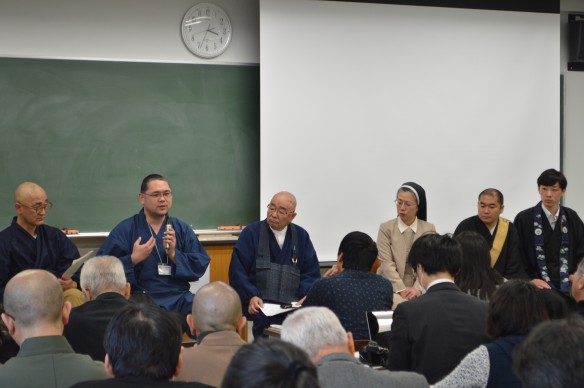

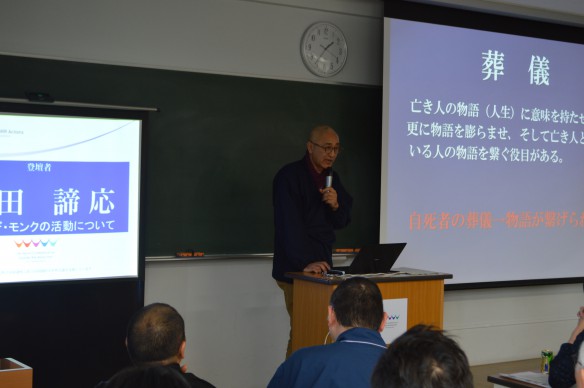
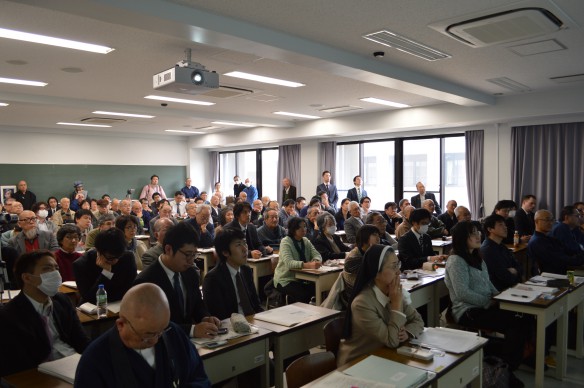
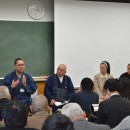
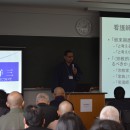
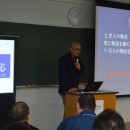
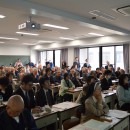
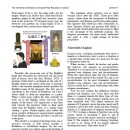 handout
handout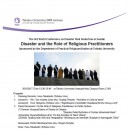 flyer
flyer

